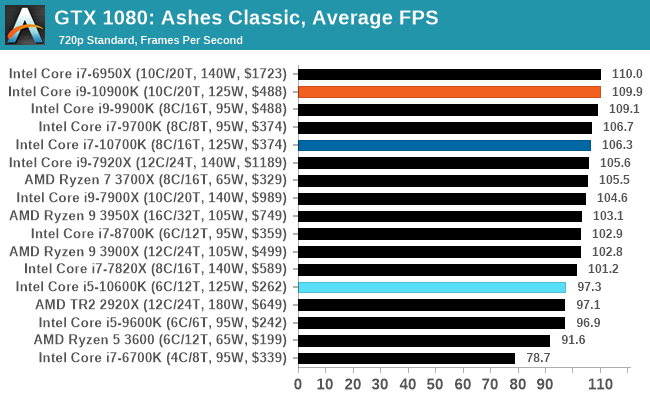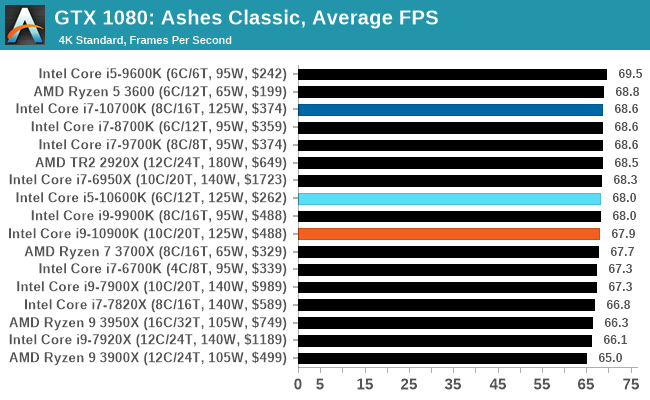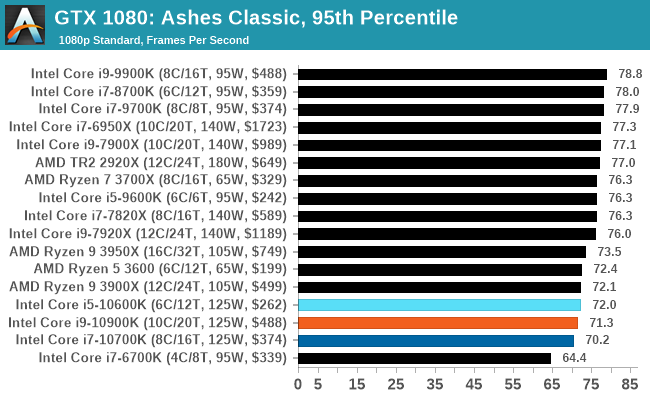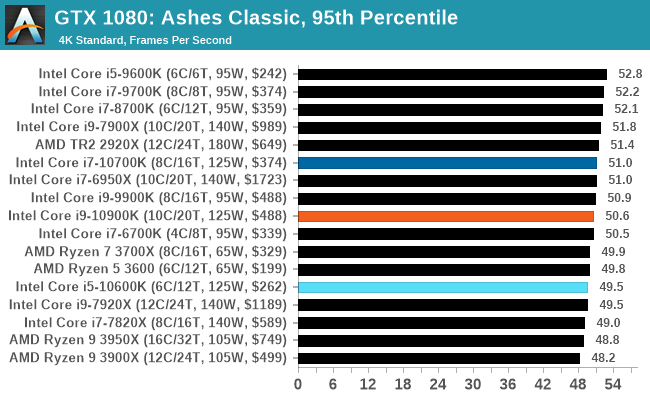The Intel Comet Lake Core i9-10900K, i7-10700K, i5-10600K CPU Review: Skylake We Go Again
by Dr. Ian Cutress on May 20, 2020 9:00 AM EST- Posted in
- CPUs
- Intel
- Skylake
- 14nm
- Z490
- 10th Gen Core
- Comet Lake
Gaming: Ashes Classic (DX12)
Seen as the holy child of DirectX12, Ashes of the Singularity (AoTS, or just Ashes) has been the first title to actively go explore as many of the DirectX12 features as it possibly can. Stardock, the developer behind the Nitrous engine which powers the game, has ensured that the real-time strategy title takes advantage of multiple cores and multiple graphics cards, in as many configurations as possible.
As a real-time strategy title, Ashes is all about responsiveness during both wide open shots but also concentrated battles. With DirectX12 at the helm, the ability to implement more draw calls per second allows the engine to work with substantial unit depth and effects that other RTS titles had to rely on combined draw calls to achieve, making some combined unit structures ultimately very rigid.
Stardock clearly understand the importance of an in-game benchmark, ensuring that such a tool was available and capable from day one, especially with all the additional DX12 features used and being able to characterize how they affected the title for the developer was important. The in-game benchmark performs a four minute fixed seed battle environment with a variety of shots, and outputs a vast amount of data to analyze.
For our benchmark, we run Ashes Classic: an older version of the game before the Escalation update. The reason for this is that this is easier to automate, without a splash screen, but still has a strong visual fidelity to test.
Ashes has dropdown options for MSAA, Light Quality, Object Quality, Shading Samples, Shadow Quality, Textures, and separate options for the terrain. There are several presents, from Very Low to Extreme: we run our benchmarks at the above settings, and take the frame-time output for our average and percentile numbers.
All of our benchmark results can also be found in our benchmark engine, Bench.

| AnandTech | IGP | Low | Medium | High |
| Average FPS |  |
 |
 |
 |
| 95th Percentile |  |
 |
 |
 |











220 Comments
View All Comments
Boshum - Wednesday, May 20, 2020 - link
Pfft. You are hilarious.Spunjji - Tuesday, May 26, 2020 - link
Maxipad, the latest in the line of Gondalf imitators.Adm_SkyWalker - Wednesday, May 20, 2020 - link
Once again I find myself debating if I should upgrade. My current i7-6950X has held up better than I thought it would. I guess it's another year or two wait for me.Boshum - Wednesday, May 20, 2020 - link
I would be good with a beast like that for 5 more years.Icehawk - Saturday, May 23, 2020 - link
I’d wait until a component like mobo dies, that’s what got me to move from a 3770 about a year ago to a 8700 - mobo died and they were pricy and old. Replaced my wife’s i5 from same gen with a 3900X though recently and gave her the intel box. I’m a gamer but I do a lot of encoding so felt AMD offered a better mix and allows me to use my 450W fanless PSU. But aside from encoding speed I barely notice a difference from that 3700.Dug - Wednesday, May 20, 2020 - link
The problem with all these charts is that they are inconsistent.There are so many variables that aren't shown that it doesn't make sense to show these.
Most of this has to do with how motherboards handle the cpu's and what their default settings do.
There can be a 15% swing in AMD motherboard default settings between brands. Not to mention things like pbo on or off, infinity fabric, memory timings, etc.
I don't know about the Intel side. I remember their settings made less difference unless it was just cpu clock speed.
shady28 - Wednesday, May 20, 2020 - link
Agree with the sentiment, but you kinda stacked the deck with that last statement.Most of the Z490s are now supporting much higher speed RAM (up to DDR4-5000) and even intel 9th gen were good at overclocked RAM, while AMD systems rarely get above 3600Mhz. It shows if you look at something like PCMark 10 where the top 100 systems on almost all of the charts is completely dominated by intel. All of them are overclocked of course, but all of the top AMD systems are also overclocked.
What I would like to see is something along the lines of a i5-10600K vs AMD 3600 vs AMD 3600X, but not using 'all the same components other than mobo and CPU'. Take those 3 chips and build the fastest system you can with them. Use that PCI 4.0 NVMe and GPU on AMD, use that 4800Mhz CAS 18 RAM on the Intel. See what happens.
mrvco - Wednesday, May 20, 2020 - link
Ok, part of me would be curious to see what Intel could (or couldn't) do with an 11th Gen spin of their 14nm process.Findecanor - Wednesday, May 20, 2020 - link
The "Security" portion of this article is not really comprehensible. I can't guess what the author is thinking. The author needs to write it down in actual words what these things mean.Security on Intel processors is what is holding me off from buying any Intel CPU for the time being.
I consider myself pretty knowledgeable about the actual vulnerabilities themselves, and how they work, and how they can be mitigated -- in theory --, but if I have not kept up with every little tidbit of news about security on Intel's processors in particular, that portion of the article tells me absolutely NOTHING.
quadibloc - Wednesday, May 20, 2020 - link
These chips are impressive, and for people with a need to build a system today, and a preference for Intel, they are reasonably competitive. So I am favorably impressed, even if AMD would remain my own choice at the moment. I still do believe that in the long run, Intel does have the means to regain leadership, so that in a year or two or five, AMD will be back to being in second place (but in second place like the previous generations of Ryzens, not like the Bulldozer years). I don't know, though, if even Intel will be able to keep up at the process end; even it may have to go fabless after 10nm, which would have significant implications for the industry.